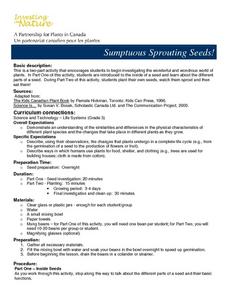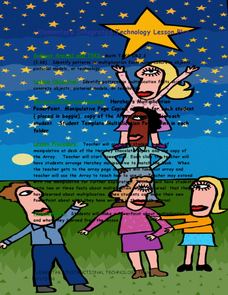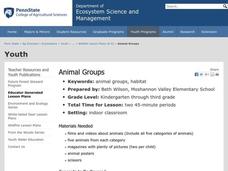Curated OER
History in the Making: The Tortilla
Fourth graders examine the history of the tortilla and extend the study across the curriculum. In this history of the tortilla lesson, 4th graders research the background of the tortilla, determine the ingredients, and work with the...
Curated OER
Animal Signs
Learners discuss the many different types of animal signs that can be used to identify and track animals. They participate in an hands-on activity in which they examine tracks, trails, homes, territory markings, and even "scat" left by...
Curated OER
Wants Vs. Needs: The Pilgrims sail to America
Students work in groups to create a list of the items needed by the Pilgrims to bring to America. For this wants vs. needs lesson, students must agree on what should be on the list. Students create their list by order of...
Curated OER
Contrasting Landscapes - UBC Farm Field Trip
Students visit the UBC Farm. In this lesson on various landscapes, students spend a day at the University of British Columbia exploring the farm and trail adjoining the campus. This lesson could be modified for use in any region that has...
Curated OER
Planning a Trip for Christopher Columbus
First graders plan a trip for Christopher Columbus. They use their math skills to construct a ship for Columbus' voyage. They show their ship and calculations to their classmates and build graphs to show the amount of supplies needed to...
Curated OER
Making Your Dog Your Best Friend
Students delve into dog training. In this biology lesson plan, students learn that hands, voice and heart is the basis of dog training and through demonstration and take part in a hands-on experience to teach a dog simple commands and to...
Curated OER
To Eat or Not to Eat?
Students identify various parts of plants and determine which parts people eat. They conduct a celery stalk experiment in which they determine the value and use of the stem, and how it helps the plant to meet its needs. Students use a...
Curated OER
Guess Who's Coming to Dinner?
Students work in groups to imagine, research and simulate a dinner party involving an author, a fictional character, and a significant historical figure as dinner guests. The activity uses Geoffrey Chaucer's Canterbury Tales and the time...
Curated OER
Sumptuous Sprouting Seeds!
Third graders investigate the wonderful and wondrous world of plants. They examine the inside of a seed, explore the different parts of a seed, plant their own seeds, watch them sprout and then eat them! They describe, using their...
Curated OER
Optimal Foraging
Students participate in a foraging activity that demonstrates environmental conditions playing an important role in determining the optimal foraging behavior of a particular organism.
Curated OER
Mixing Colors
Students listen to a story about mixing colors. They explore color using cups of water, color and coffee filters. They use sight word vocabulary to describe the colors.
Curated OER
Geographic Features and Human Settlements
Third graders examine geography and settlements. In this geography lesson, 3rd graders participate in classroom activities that center on the idea that people settle where there are geographical features that sustain life.
Curated OER
Patterns In Multiplication
In this patterns in multiplication worksheet, students, working with a partner, problem solve and calculate the answers to fifteen word problems or mathematical equations involving patterns in multiplication.
Curated OER
Cats
Students participate in an after school program that promotes communication with others, solving problems, and making decisions. They experience getting in touch with themselves, about cats, training cats, showing cats and explore...
Curated OER
"Julie of the Wolves"
Fifth graders research life in Alaska and compare life there to their lives in this lesson. They read "Julie of the Wolves." They research through the novel and other reference books facts about the Alaskan climate and geography. They...
Curated OER
Tree Friends
Students are introduced to tree structure and use. They identify their special tree using all senses except sight. Students identify six different internal parts within a cross section of tree trunk (bark, phloem, xylem, cambium,...
Curated OER
Beaver Ecology
Students explore the lives of bgeahvers. They identify the physical and behavioral adaptations that help beavers survive in their environment. Students compare and contrast how beavers influence the ecology of both forest and aquatic...
Curated OER
Exploring Careers in Aviation
Young scholars investigate various careers in the field of aviation in this lesson. They watch and discuss a video, develop a list of careers in aviation mentioned in the video, and create a resume and cover letter for an entry level...
Curated OER
Headlines of the Past
Students study the lives of four Native cultures. They examine the people that inhabited Wisconsin over the last 12,000 years. They create a newspaper and imagine themselves as a reporter living during this time period and sharing a day...
Curated OER
The Living Environment
Fourth graders make a chart of animals and plants that live in either the desert, the ocean, or the tundra. In this environment lesson plan, 4th graders work in groups to discover characteristics needed for these animals to live in that...
Curated OER
Animal Groups
Learners explore animal groups. For this animal science lesson, students use pictures from magazines and classify the animals into five categories. Learners share why they categorized the animals the way they did.
Curated OER
Finding Caterpillars
Students examine how animals protect themselves from predators and camouflage themselves. They participate in a simulation in which they locate red and green yarn "caterpillars," organize their data, and generate a bar graph using...
Curated OER
Gas Laws Experienced
Young scholars discover relationship between temperature pressure and volume as they perform research and experiments.
Curated OER
Parental Responsibilities
Students discuss their responsibilities and experiences as parents. Individually, students create a list of parental responsibilities. Individual lists are combined and discussed with the whole class. This lesson is designed for...

























